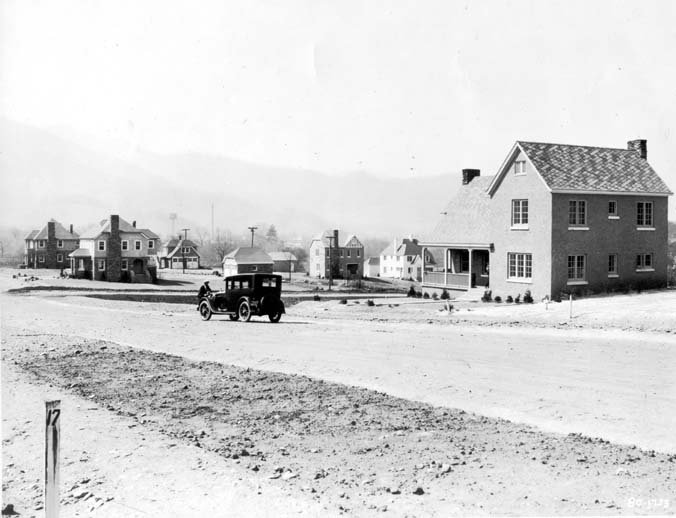In 1924, developer E.W. Grove had his hands full with two major projects — the construction of the Battery Park Hotel, which was completed that September, and the far more ambitious undertaking of Grovemont-on-Swannanoa, billed as America’s first planned community.
Reports of the latter were announced in The Sunday Citizen on June 15, 1924. The paper declared that the 500-acre tract, located half a mile east of the town of Swannanoa, was designed with more than 500 residential lots and 100 business lots in mind, along with properties reserved for churches, schools, a town hall, library and post office. In addition to these future structures, the paper wrote, “The entire mountainsides and valleys will be converted into a fairyland of lakes, parks and floral gardens.”
Coverage of the announcement continued in the following day’s paper. “Grovemont-on-Swannanoa is to be an example of what a municipality can be when it is planned from the beginning by experts who take the same pains with town-building that architects exert in constructing houses,” The Asheville Citizen proclaimed.
The article went on to state:
“If this experiment should be successful, and all the evidence prophesies success, Grovemont ought to be the first of many suburban towns in this section to be built within the next ten years. Good roads and automobiles are changing the conditions which in the past have forced people to cramp themselves into city areas that have become so crowded that for many there was literally not room to breathe, much less space for safe and convenient movement of pedestrians and vehicles.”
In a full page advertisement featured in the July 13 edition of The Sunday Citizen, Grove laid out the intention behind his latest project. According to the developer, Biltmore Forest, Beaver Lake and Grove Park all catered “to practically the same class of people,” limiting the area’s potential growth. Grovemont, he argued, would induce tourists “to buy lots and build medium-priced, but attractive bungalows to cost on the average of $3,000 to $5,000” (roughly $45,000 to $75,000 in today’s dollars). The result, he asserted, would be a win for both the new homeowners and Asheville, bringing “the largest number of satisfied people” to the region.
The following day’s paper expanded upon Grove’s case. “In some portions of the east the impression that Asheville is exclusively a resort for the wealthy has gained some headway, and this doubtless keeps many away from here,” The Asheville Citizen wrote. Grovemont, the paper insisted, would remedy the current situation by “providing reasonably priced accommodations for the thousands who come here each summer[.]”
Hype in the form of frequent newspaper advertisements continued throughout the next three years. On Oct. 6, 1924, one announcement offered a timeline of the development’s progress, noting that since its June 15 founding, 586 applications had been submitted, with 12 houses already under construction.
Another advertisement, featured in The Sunday Citizen’s Jan. 25, 1925, edition, asked readers to consider what true American prosperity looked like. Not surprisingly, the answer was Grovemont-on-Swannanoa. “In the quiet of the country with one’s lungs filled with the clean mountain air there is a feeling of exhilaration, a taste of perpetual youth,” the ad promised.
Throughout 1925, the paper continued to report on sales of both residential and business lots, alluding to the imminent construction of drug, grocery and general merchandise stores, as well as two garages and an automobile supply shop. Meanwhile, similar notes were struck in Grove’s ongoing advertisement campaign.
Yet things took a turn in 1926. On March 7, The Sunday Citizen reported on Grove’s recent plans to construct his newest home in the Grovemont-on-Swannanoa development. In addition to joining the community, Grove offered to finance the first 50 homes built on lots under his ownership. “Plans for building in Grovemont have assumed large proportions, it is said, and Mr. Grove’s offer will start a remarkable growth in that section, it is thought,” the paper read.
Growth, however, remained stagnant throughout 1926. And in the following year, on Jan. 27, 1927, Grove died at the age of 77. His death, followed by the 1929 market crash, ultimately killed the project.
According to Anne Chesky Smith’s 2013 book, Images of America: Swannanoa, 19 homes were constructed in the planned community. Today, 15 of the properties remain. “Though E.W. Grove’s dream of a quaint English village … was never fully realized,” Chesky Smith writes, “the Grovemont of today is still a web of streets anchored by a central park, which has been rebuilt to feature a playground, a walking path, and a playing field,” as well as the Swannanoa Library.
Editor’s note: Peculiarities of spelling and punctuation are preserved from the original documents.




Before you comment
The comments section is here to provide a platform for civil dialogue on the issues we face together as a local community. Xpress is committed to offering this platform for all voices, but when the tone of the discussion gets nasty or strays off topic, we believe many people choose not to participate. Xpress editors are determined to moderate comments to ensure a constructive interchange is maintained. All comments judged not to be in keeping with the spirit of civil discourse will be removed and repeat violators will be banned. See here for our terms of service. Thank you for being part of this effort to promote respectful discussion.